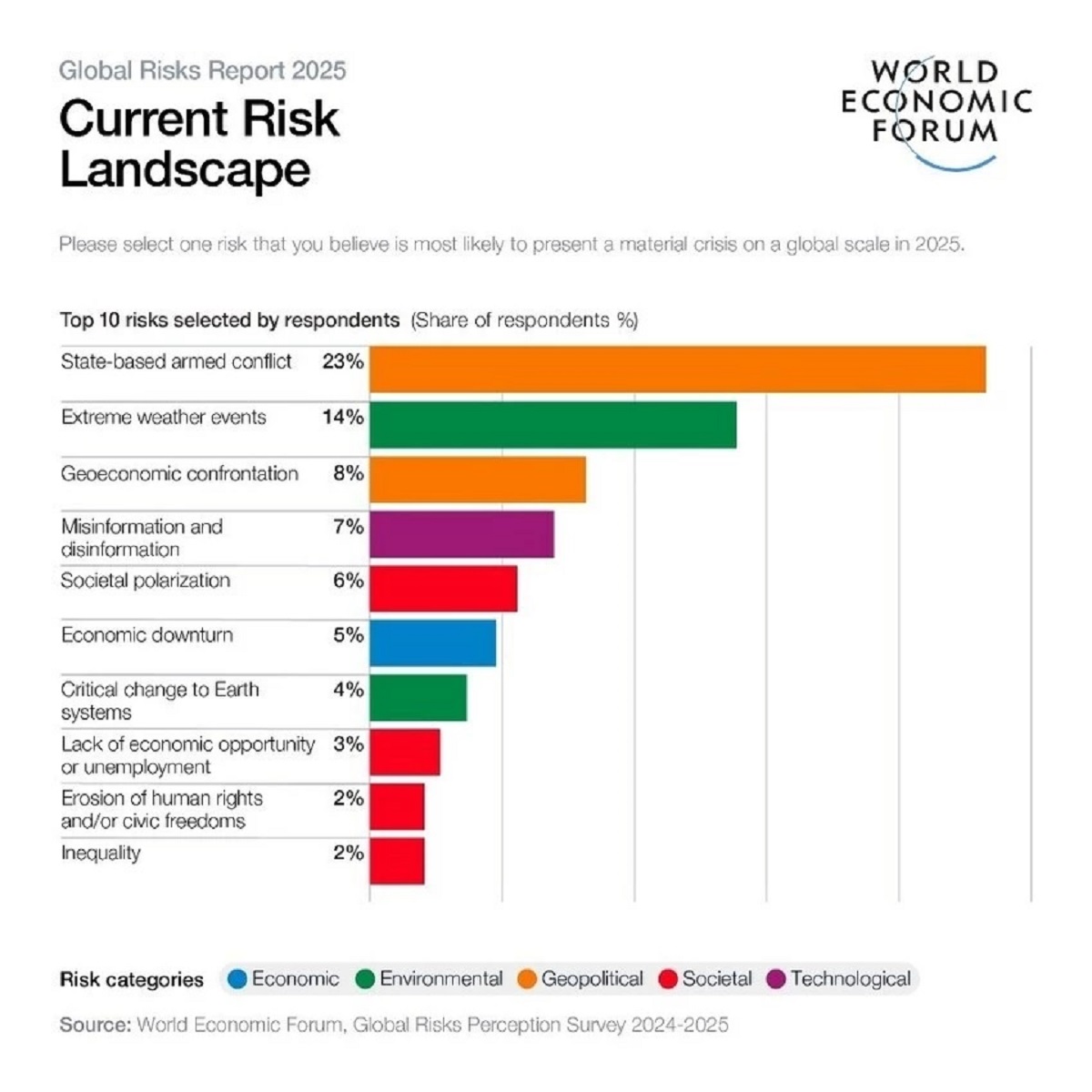Submitted by Emina Čamdžić
Cities as GDP Resources: Only 37% of the 500 Largest Cities have Nature Strategies, reports reveal
Switzerland Architecture News - Jan 27, 2025 - 16:02 3424 views

"Collaboration for the Intelligent Age" is the theme of the Annual Meeting of the World Economic Forum 2025 (WEF25). On this theme, the Global Risks Report by the WEF 2025 has been published. During the launch of the report, is stated that the report represents "a mosaic of shaping the agenda for the Meeting in Davos."
One of the five pillars of this year's WEF is "Safeguarding the Planet", which focuses on solutions on climate and nature solutions, then advancing decarbonisation efforts.
The 104-page report, titled Global Risks Report, presents the summary of results of the Global Risks Perception Survey taken by 900 global leaders and 100 thematic experts, exploring and analysing the geopolitical, social, economic, and environmental risks in the world.
According to this report, 88% of respondents to the survey anticipate an unsettled outlook this year; while "there is a sense of uncertainty" is stated at the launch of the report.

Image of the graph view Global Risks Perception Survey 2024 - 2025. Image © World Economic Forum
According to the same report and on the graphics view above, conflicts are identified as the foremost risk accounting for a significant 23% of responses in the survey, while another 14% of respondents highlighted extreme weather events, which as elementary disasters present a significant risk indicating their growing prevalence and impact in contemporary society.

Image of the impressions from the World Economic Forum Annual Meeting 2025 in Davos-Klosters, Switzerland. Image © World Economic Forum / Boris Baldinger
The report predicts that in the long-term, environmental and climate-related risks dominate the 10-year horizon, from extreme weather events then biodiversity and ecosystem challenges. The report launch underscored the impact of these risks, which are not merely isolated incidents. As a result, understanding and addressing the mentioned risks is essential for developing strategies that can effectively safeguard communities and foster resilience from these challenges.
Even in the short term, elementary weather events are challenging and visible. In addition, pollution is stated as another environmental risk perceived as a leading risk in the short term. Moreover, the report mentions that there is a growing concern about serious health and ecosystem impacts of "a wide range of pollutants across air, water and land" and therefore as pollution is increasing and accumulating, it’s important to address pollution.
"Extreme weather events are anticipated to become even more severe, with the risk ranked as first over the next decade for the second year running. Biodiversity loss and ecosystem collapse rank #2, up from #3 last year and with a significant deterioration compared to its two-year ranking (#21). Critical change to Earth systems at #3, Natural resource shortages at #4, and Pollution at #10 complete the very bleak outlook for environmental risks."
Technological advancement has become a defining characteristic of the modern era, fundamentally transforming industries, economies, and societies. Artificial intelligence, renewable energy, and other fields are reshaping how we live and work. These advancements create new opportunities for growth and development.
In this context, the need for support from policymakers and ensuring support for risk management, is mentioned during the launch of the report. Policymakers create an environment that fosters innovation while addressing challenges that accompany technological change and support sustainable growth.

Image of the impressions from the World Economic Forum Annual Meeting 2025 in Davos- Klosters, Switzerland. Image © World Economic Forum / Thibaut Bouvier
Another recent report published for the WEF25 is titled "Nature Positive: Financing the Transition in Cities - Insight Report".
This, 47-page report emphasises that "482 million dollars in a year in health costs could be saved by adding urban trees in 10 of the world's megacities" and that is a result of the ability of urban trees" to remove carbon dioxide and other pollutants from the atmosphere". There are currently 33 megacities according to research and could be 43 megacities in the world until the year 2030. Read more about read here and on this page.
The report further reads that only 37% of 500 most populated cities in the world have strategies to manage and protect nature, while there is a decline in budget spending on urban nature in the recent years. Although governments are the main financers of urban development and nature support by creating policies and frameworks, only less than 0,1% of national budgets is spent on biodiversity, is furthermore stated in the "Nature Positive: Financing Transition in Cities - Insight Report."
"There are numerous avenues through which cities can look to incorporate nature into their urban development plans. From the presence and integration of natural elements into urban environments and landscapes, such as through nature- based solutions, to policy and regulatory measures," the report adds.
In addition, this report states the following: "Urban parks and green spaces can increase property value by 9,5%, while green roofs and walls offer 6,7% and 8% energy savings, respectively, to limit the heat island in urban centres."
"Nature-positive finance: refers to investment into solutions that have a measurably positive impact on ecosystems and biodiversity against a set baseline (colloquially called 'financing green')."
Cities represent the world’s economic centers, functioning as vital engines of growth and innovation by contributing an impressive 80% of the global GDP, which is stated in the same report. However, according to this report, it is crucial to acknowledge that 44% of the economic output is endangered by the ongoing loss of natural ecosystems and biodiversity.
The degradation of natural habitats poses a significant challenge to the sustainability of urban economies. As cities continue to grow, become more populated, and evolve, the interdependence between urban development in natural ecosystems becomes more visible. Therefore, it is understood that addressing the challenges posed by nature loss is not merely an environmental concern, it is an economic imperative of cities and towns that requires immediate action from policymakers, businesses, and communities.
Top image in the article: the World Economic Forum Annual Meeting 2025. Image by the World Economic Forum / Valeriano Di Domenico.
> via WEF
cities decarbonisation Global Risk Report nature report WEF25
